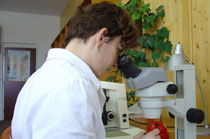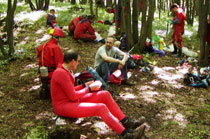The aim of the basic inventory research of invertebrates in individual caves is receiving knowledge on species composition, which speaks about the measure of representation of troglobite and stygobite forms of organisms, or other interesting, rare, threatened and protected species. In water biocenoses we observe the structure and distribution of plankton and benthos societies of invertebrates in stagnant and running underground waters. Especially are monitored biotic components in places along show paths and away from them. Mutual comparison of results will help us to evaluate the state of underground waters quality in relation to artificial impacts on water biota. The secondary research is related to surveying the species composition of adjacent ponors and springs on the surface, which can be or are interconnected with water habitats underground. This can give us better knowledge on mutual relations and sources of species in surface and underground biota. Within the research of terrestric biocenoses of fauna, the biospeleologic stationary spots are stabilized, where observations and representative collection of animals are done. The research is oriented to determination of species diversity, abundance, spatial distribution and succession of terrestric invertebrates societies, mainly selected arthropods, which make the most important component of cavernicolous fauna.
The long-term subject of interest of the Slovak Caves Administration in monitoring of bats. We study the species composition, abundance and spatial distribution of chiropterofauna in years phases, mainly during the winter. The regular long-term monitoring in show caves enables to record continuous changes of bat populations state to be able to confront it with known data e.g. with changes of natural conditions, number of visitors, technical maintenance etc. The bat monitoring in wild caves is aimed at finding and prediction of the most important localities for bat hibernation or reproduction and monitor the extent of possible threats (disturbation, making fire at cave entrance, other forbidden activities). The priority in these locations is to secure higher level of protection. It is realized by more frequent inspections of the speleological guard service – rangers, or by closing the cave entrances by grating with suitable openings for bats to fly in and preventing unwanted people to enter.
The Slovak Caves Administration supports tasks connected with palaeontological research. It is oriented to discovering of fossil and subfossil skeleton remains of vertebrates. A great importance has the determination of exact age of the findings using the 14C method. This will give us a real picture of the landscape in the past, which in connection with the study of climate changes can offer possible solutions to topical environmental problems. The Slovak Caves Administration cooperated in preparation of palaeontological exposition of cave bear in the Važecká Cave and supported dating of the fossil remains of this animal from the cave.
 Activities oriented to monitoring and protection of bats prevailed up to the 2003. During 2004-2005 two biospeleologists were employed, with active participation on research of invertebrates. The middle-term perspective is to strengthen the field of bat research. Since the problems of biospeleological research are large a cooperation with other research and protection institutions in Slovakia and abroad is necessary.
Activities oriented to monitoring and protection of bats prevailed up to the 2003. During 2004-2005 two biospeleologists were employed, with active participation on research of invertebrates. The middle-term perspective is to strengthen the field of bat research. Since the problems of biospeleological research are large a cooperation with other research and protection institutions in Slovakia and abroad is necessary.
 It is necessary to continue in inventory research, observation of negative impacts on cave biota firstly in caves designated national nature monuments and other localities important from the biospeleological point of view. The practical application of research will help in working up of proposals for practical protection measures. The observations can be applied also in newly discovered caves to be able to compare with later periods.
It is necessary to continue in inventory research, observation of negative impacts on cave biota firstly in caves designated national nature monuments and other localities important from the biospeleological point of view. The practical application of research will help in working up of proposals for practical protection measures. The observations can be applied also in newly discovered caves to be able to compare with later periods.
The long-term perspective can be aimed at creating conditions for experimental forms of research, ecology of selected species, determination of spatial distribution or taxonomic classification of species. An interesting task could be analyses for comparison of species living on border territories of two states as for the potential duplicity.
The primary aim of the biospeleological section will be the protection of underground habitats and organisms.
Dear visitors, visiting the cave requires adequate physical fitness.
The route includes:
- a longer walk in an enclosed darkened area
- reduced temperature and increased humidity
- ascent and descent
- higher number of steps (in some caves)
Special note to persons with medical limitations:
If you suffer particularly from cardiovascular disease, respiratory problems, high blood pressure, mobility limitations or are in poor physical condition, please consider taking part in the tour.
If you have any doubts about the appropriateness of your visit, please consult your doctor about your medical condition.
Your safety is of paramount importance to us.
Thank you for your understanding
Slovak Caves Administration, State Nature Conservation of the Slovak Republic
Dear visitors, we would like to inform you that due to the technical conditions of payment terminals, there may be situations when card payment will not be possible. For this reason, we recommend that you have an adequate amount of cash available if you want to be sure that you will be able to visit the cave. Thank you for understanding.
Dear visitors, due to technical reasons at the cave, it is not possible to provide food and drinks, including coffee vending machine services. We apologize for this inconvenience.
Dear visitors, the parking lot doesn't belong to cave administration. The fees are collected by different entity. Thank you for your understanding.